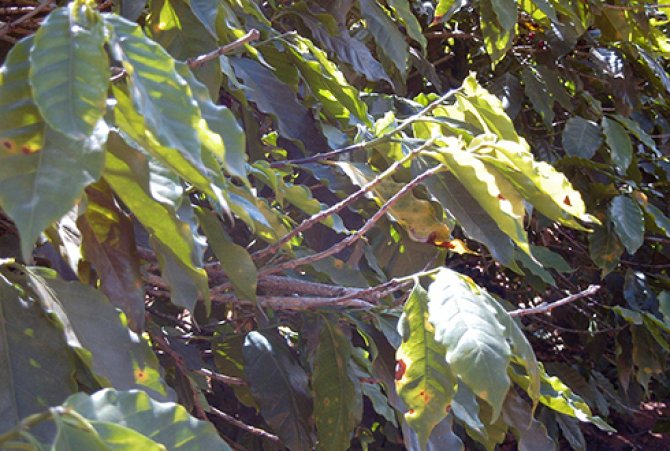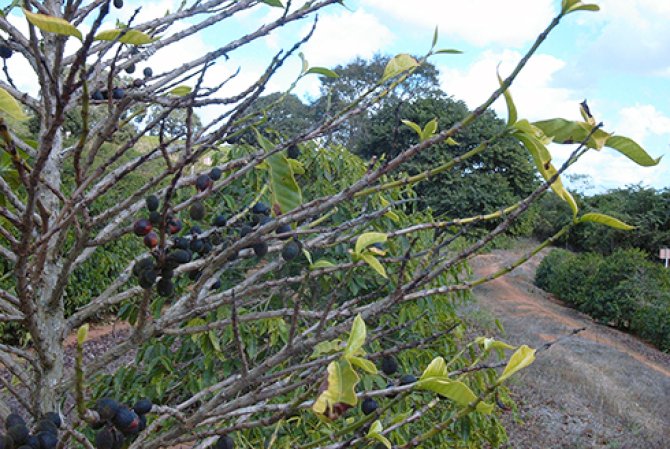
10 questions about Xylella fastidiosa
Xylella fastidiosa is a bacterium that causes a lot of damage and therefore has a quarantine status within the EU. The experts at Wageningen University & Research use their knowledge about plant pathogenic bacterial diseases for the detection and recognition of this bacterium and later possibly also for its control.
1. What is Xylella fastidiosa?
Xylella fastidiosa is a non-spore-forming, rod-shaped bacterium. Taxonomically it’s a complicated species made up of various groups. There are currently four known sub-species: X. fastidiosa subsp. fastidiosa, X. fastidiosa subsp. multiplex, X. fastidiosa subsp. sandyi and X. fastidiosa subsp. pauca. Each sub-species can affect multiple host plants, with more than 300 host plants affected by the bacterium species as a whole. A list of EU host plants of the European Commission is regularly updated.
The Xylella bacterium lives in the vessel elements of infected plants. The bacterium can move against the sap flow (the transportation of water from the roots to the leaves). The sap flow becomes disrupted and large parts of the crown or foliage dry out and die off. As far as we know, the bacterium is not transmitted through seeds.
Symptoms of Xylella
Symptoms vary depending on the crop. They include dieback of branches, brown leaf edges, leaf scorch and yellowing. Plants can also be infected for a long time without displaying symptoms. Many host plants never display any symptoms.

2. What is the problem with Xylella fastidiosa?
Xylella fastidiosa has quarantine status within the EU (EPPO A2 list). This is a list of damaging organisms which are not found in the EPPO region and which are regulated. Imported host plants are therefore checked for the presence of Xylella. In 2013 Xylella was found on olive trees in Italy. In 2014 and 2015 imports of ornamental coffee plants from Costa Rica and Honduras were intercepted and the bacterium identified by various EU members states. In 2015 the bacterium was found in Corsica on ornamental Polygala myrtifolia (sweet pea bushes). The bacterium has now also been found in the south of France (in and around Nice).
In December 2015 the European Commission made further changes to the control measures for Xylella fastidiosa. All host plants found to be contaminated in the EU are required to have a plant passport. More information on this is available on the website of the Netherlands Food and Consumer Product Safety Authority (NVWA) (in Dutch).

3. How does the bacterium spread?

Xylella is transported within a plant through the xylem (the vessel elements of the plant, which carry water and water-soluble materials from the roots to the leaves). The bacterium spreads from plant to plant by means of feeding insects such as plant lice and froghoppers. It survives in the vectors and can even multiply slightly in the insect's oesophagus. Once the insect has picked up the bacterium, it can be transmitted directly somewhere else. The role of a specific vector in transmitting the bacterium depends on the quantity involved and the efficiency of the transmission. The eggs of the infected insects are not themselves infected.
The bacterium is not thought to be spread through hands, tools and so on. However, infected plant materials can spread the infection.
4. What happens if Xylella appears in the Netherlands?
High temperatures and water stress encourage the growth of Xylella. It’s therefore expected that any symptoms in outdoor crops in the Netherlands will develop slowly, if at all. Incidence of the bacterium is likely to be dispersed and will therefore be difficult to track down. If any infected materials are exported from the Netherlands to warmer climates, symptoms could develop. Some farmland weeds such as nettles and euphorbia are known to be Xylella hosts.
5. In which significant crops does Xylella cause significant problems?
- Citrus in Brazil: Citrus "Variegated chlorosis"
- Grape cultivation in California (USA): “Pierce’s disease”
- Olives in Puglia, Italy: “Olive tree blight”
- Peach: “Phony disease”

6. How can the disease be tackled?
No chemical crop protection agents are available to combat Xylella. Biological controls against the bacterium or the vectors of the bacterium might eventually have some potential. But so far, these have not been successful. Injecting trees with antimicrobial materials has also never produced results.
In the US, a combination of measures is used: cultivating clean starting materials in insect-free tunnels or greenhouses, monitoring programmes, removal of diseased materials, weed control, and the use of contact and systemic pesticides.
Plant breeding programmes are working on grapes and citrus, but it could be 20 years before any resistant varieties are produced. For almonds, the use of resistant rootstock is looking promising.
At present, when the disease is identified the only available measures to stop it spreading are preventative: destroying affected trees and plants, applying buffer zones around an outbreak site, and checking plants imported from areas affected by Xylella.
7. What action is being taken to stop the spread?
In 2014 the EU announced an emergency measure whereby 27 plant genera and 160 plant species were banned from import into the European Union for the time being. This will only be relaxed if a particular country can show that Xylella fastidiosa is not found there.
8. How is the control of Xylella being researched?
At the European level various initiatives are underway to develop and gather expertise. The EU’s EUPHRESCO programme is compiling expertise on Xylella and allocating tasks in order to avoid duplicated research. A new EU project has also started to look into Xylella host plants. This EU research is focusing on:
- The density and spread of Xylella in plants
- Development of expertise on vector biology
- Field research on host plants for the two Xylella strains found in Europe
- Standardisation of testing methods for diagnostics and resistance
- Availability of resistant genotypes, starting with olives
There is currently a Call for Xylella research as part of the EU’s Horizon 2020 research programme. Wageningen University & Research is taking part in this.
In the Netherlands, a three-year Xylella research project started in 2016 in association with TopSector Horticulture and Starting Materials (Topsector Tuinbouw & Uitgangsmaterialen). Wageningen University & Research’s role in this has been to carry out research into isolation protocol, host plant ranges, sampling and diagnostics.
9. What does WUR have to offer in the control of this bacterial disease?
Wageningen University & Research researchers have a great deal of expertise in plant pathogenic bacteria. This includes:
- Growing media
- Phylogeny and genomics
- Diagnostic tools
- Host plant studies including screening and selecting for resistance
- Epidemiology
- Knowledge of insects as vectors of diseases
- Knowledge of bacteria and bacterial diseases
- Biological controls
- Formulating a set of Good Practices to limit risks
WUR also has a lot of practical expertise in diseases and infestations in trees, and in tree cultivation and fruit crops. For example, tree researcher Jelle Hiemstra took part in the EU project Vertigeen. The aim of this project was to develop a method for the early detection and quantification of the common Verticillium wilt disease in olive trees. The Vertigeen system was an innovative way of bringing together some new but successfully demonstrated techniques: the LAMP method (Loop mediated Isothermal Amplification) and in-solution electrochemical detection of DNA. WUR also created a Guide of Best Practices for combating this infestation in olive trees.
10. Where can more information on Xylella fastidiosa be found?
- On the NVWA website (in Dutch), covering spread, biology and symptoms
- On the EPPO website (First report of Xylella fastidiosa in the EPPO region)
- On the European Food Safety Authority (EFSA) website (on the role of the EU)